Introduction
Although the Chinese yuan has been buoyed by upward pressure in recent years, as clearly demonstrated by the increase China's balance of payments surplus and the ensuing sharp accumulation of foreign exchange reserves, the Chinese government has been cautious about revaluing the yuan out of concerns over the adverse effects on the domestic economy. However, as the monetary authorities need to continually intervene in the foreign exchange market to maintain exchange rate stability, foreign exchange reserves have been increasing rapidly while liquidity has been expanding in the domestic market. As a result, corresponding adverse effects, for instance a ballooning bubble for assets such as stocks and real estate, and rising inflation have already come to the forefront. Also, monetary policy is not being fully utilized as a means to stabilize the macro economy, with its focus instead placed on stabilization of the exchange rate. To correct the external imbalance and restore monetary policy independence, China must change its foreign exchange system to a freely floating one in which the authorities in principle do not intervene in the market, and leave determination of the exchange rate to the demand and supply of the currency in the market.
China's transition to a floating exchange rate system began with the "yuan reform" implemented in July 2005, when China moved from a conventional dollar peg system to a managed floating rate system. However, with the foreign exchange policy focusing on "managing" rather than the "floating" aspect, even after the move, the authorities have continued to engage daily in heavy market interventionto curb the rise in the yuan. As a consequence, monetary policy independence still remains significantly restricted.
The current situation in China is similar to that in Japan in the early 1970s when the country was forced to move from a fixed exchange rate system to a floating rate system. Triggered by the so-called Nixon Shock in 1971, Japan, after a series of twists and turns, completed the transition in February 1973. Many commonalities exist between these two cases in terms not only of the macroeconomic environment, but also of the policy debate centered on foreign exchange policy. In this analysis, I will look back on Japan's experience at that time in light of the current situation in China and draw out lessons from which China should learn.
1. The Yuan's Unfinished Reform
In China, foreign exchange reserves have been sharply increasing since around 2003 and reached $1.8 trillion in June 2008, reflecting China's large surplus in both its current account centered on trade and its capital account centered on foreign direct investment (a "twin surplus"; figure 1 ). Under a freely floating exchange rate system, authorities do not intervene in the foreign exchange market and, therefore, foreign exchange reserves do not increase. Even if the current account runs a surplus, as currently observed in Japan, it is automatically offset by a capital account deficit. The phenomenon in which foreign exchange reserves continue to increase in China is merely the result of continued intervention by the Chinese authorities to curb the yuan's rising exchange rate or, put another way, to keep the exchange rate below the market equilibrium level. If the authorities were to refrain from intervention, foreign exchange reserves would stop rising and the exchange rate would appreciate instead ( figure 2 ).
In tandem with this pressure in the market, major trading partners of China, including the United States, have been gradually heightening calls for revaluation of the yuan. Although the Chinese authorities were initially reluctant to revalue because of concerns over adverse economic effects associated with an appreciating yuan, such as decelerating exports, deteriorating employment conditions, and deflationary pressure; they did ultimately revalue the yuan by 2.1 percent on July 21, 2005, following strong pressure from the market and foreign governments. At the same time, the authorities abandoned the dollar peg system that China had previously adopted, and embarked on the present policy of "reform to improve the exchange rate formation mechanism of the yuan" (yuan reform).
Figure 1: Rise in China's balance of payments surplus and foreign exchange reserves
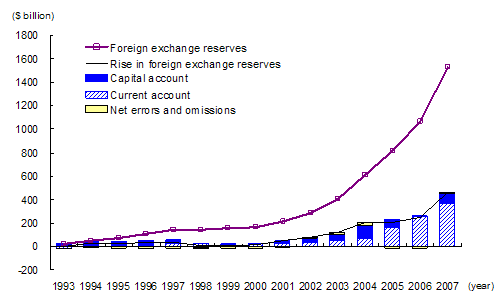
(Note) Rise in foreign exchange reserves = current account balance + capital account balance + errors and omissions.
(Source) State Administration of Foreign Exchange http://www.safe.gov.cn/
Figure 2: Mechanism of increasing foreign exchange reserves
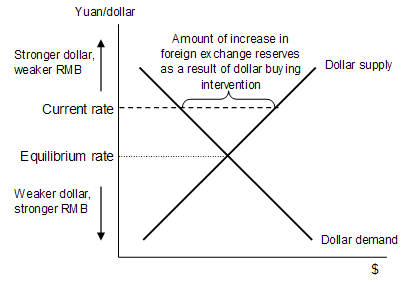
(Source) Prepared by author
At that time, a spokesperson for the People's Bank of China (PBOC), China's central bank, explained China's motivation for modifying the foreign exchange rate formation mechanism of the yuan as follows ("Why China implements a reform to improve the foreign exchange rate formation mechanism of the yuan," Xinhua News Agency, July 21, 2005 ).
"Promotion of reform of the yuan's foreign exchange rate formation mechanism is based on the need to alleviate foreign trade imbalance, expand domestic demand, improve companies' international competitiveness, and raise the country's level of openness to the world. Surpluses have been expanding in both current and capital items over the last several years, which have been aggravating the imbalance of balance of payments. As of the end of June 2005, China's foreign exchange reserves had reached $711 billion. The trade surplus has increased sharply since the beginning of this year [2005], and trade friction is escalating."
In light of these developments, the spokesperson pointed out that China's appropriate adjustment of the exchange rate and modification of the mechanism would provide a number of benefits:
(1) Thoroughly carry out strategies for sustainable economic development centered on domestic demand, and improve the allocation of resources;
(2) Bolster monetary policy independence and improve the proactiveness and effectiveness of monetary control;
(3) Maintain the basic balance between exports and imports and improve the terms of trade;
(4) Maintain price stability and reduce company costs;
(5) Promote the transformation of management systems of Chinese companies, strengthen their independent development capabilities, accelerate their conversion to a more advanced trade model (based on high-value added exports), and bolster their international competitiveness and capabilities in response to risks;
(6) Improve the composition of capital inflows and make more efficient use of foreign capital;
(7) Make better use of resources and markets both domestically and overseas, and open China further to the world;
To achieve those objectives in the new system characterized by managed floating, the central bank would no longer link the yuan only to the dollar, but also refer to the multilateral effective exchange rate of the yuan based on a basket of currencies when formulating its exchange rate policy. Referring to a basket of currencies means that changes in rates between foreign currencies will affect the yuan exchange rate against the dollar, but it does not mean "pegging to a basket". Rather,, exchange rate policy would also take into consideration the demand-supply balance in the market.
2. Assessment of the Yuan Reform
Dr. Yu Yongding, then a member of PBOC's monetary policy committee, described the foreign exchange regime China adopted in July 2005 as a managed floating system based on the so-called BBC rules--band, basket, and crawling (allowing the exchange rate to appreciate or depreciate at a more or less predictable rate)--that appear in textbooks on international finance (Yu, 2005). However, since the introduction of the new regime, the yuan's rise against the dollar has been suppressed by the authorities' market intervention, and the operation of the exchange rate policy has focused more on "control" than "crawling." As a reflection of this policy stance, at the start of the yuan's rise against the dollar, the rate of appreciation was kept at around 1 percent annually, but the authorities have allowed the yuan to appreciate faster since 2007 as part of their anti-inflation measures ( figure 3 ).
Figure 3: Accelerated appreciation of the yuan in step with inflation
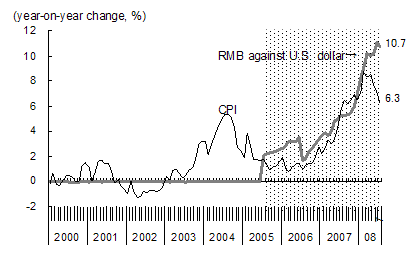
(Source) Prepared based on data from Wind Information
More than three years have elapsed since the commencement of yuan reform. In retrospect, among the authorities' seven targets for the policy change, some positive results have been attained toward objectives (1), (3), (5), and (7) but none yet toward (2), (4), or (6). (Zhou and Tang, 2008)
The objectives that have more or less been achieved can be evaluated as follows. First with respect to (1), while exports have been decelerating, consumption remains relatively firm. Regarding (3), the trade balance has finally started to fall since the beginning of 2008. As for (5), the share of exports held by labor-intensive products such as textiles, has been declining, while the share held by capital- and technology-intensive products such as machinery, has been rising. Finally, with regard to (7), China's outward foreign direct investment is rapidly increasing, and the country's openness to the world has moved from the stage where foreign companies come to China to the stage where Chinese companies now venture overseas.
On the other hand, to realize the objectives that have not yet been achieved, the following outstanding issues need to be dealt with properly. First regarding (2), as expectations for further appreciation of the yuan continue, a significant amount of "hot money" continues to flow into China. To control the rise in the yuan associated with this inflow of hot money, the Chinese authorities are forced to continue large-scale intervention in the foreign exchange market, which has caused liquidity to balloon and has significantly constrained monetary policy independence.
Regarding (4), the expansion of liquidity resulting from this market intervention has led to accelerated inflation. With the added inflationary pressure stemming from sharp increases in the international prices of primary commodities such as crude oil and a rise in the exchange rates of major currencies such as the yen and euro against the dollar , the moderate appreciation of the yuan against the dollar seen thus far is insufficient for curbing imported inflation.
Additionally, with regard to (6), hot money anticipating further appreciation of the yuan has accounted for the majority of capital inflow into China. This inflow not only makes monetary policy operations more difficult, but also raises the risk of capital being withdrawn from China within a short period, which could trigger a financial crisis.
Thus the July 2005 alteration of the foreign exchange system was only the first step toward yuan reform. The authorities will have to reduce their intervention as much as possible and leave exchange rate decisions to the market in order to achieve the objectives of the floating exchange rate system.
3. Japan's Transition from a Fixed to Floating Exchange Rate System
These circumstances China now faces are similar to Japan's situation at the time of the Nixon Shock. Under the Bretton Woods regime, Japan adopted a fixed rate system, setting an exchange rate of ¥360 to the dollar, and regarded the maintenance of this rate as the monetary policy's top priority. However, in the 1960s, a chronic deficit in the United States' balance of payments through reflected capital outflow began to shake confidence in the dollar as the key currency. Meanwhile Japan had just been through a high-growth period, had raised the international competitiveness of its exports, and since around 1968 had overcome a deficit and maintained a current account surplus. As the surplus increased, foreign exchange reserves, which had remained around only $2 billion before 1967, significantly increased to $4.4 billion by the end of 1970, and to $7.9 billion by the end of July 1971, just before the Nixon Shock ( figure 4 ). In this environment, expectations for a revaluation of the yen were rising day by day.
Figure 4: Changes in Japan's current account balance and foreign exchange reserves - centered on the transition period to a floating rate system
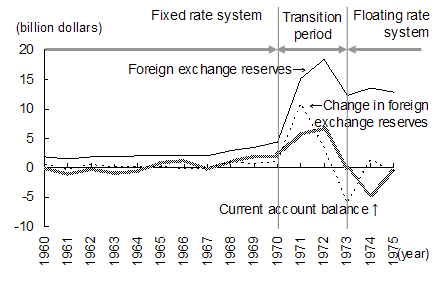
(Source) Prepared from Bank of Japan data
In 1971, the U.S. lowered the official discount rate three times to stimulate the economy despite the fact that its balance of trade fell into deficit for the first time since World War II, and the interest rate differential with European countries widened. Owing to the prospect of a devaluation of the dollar, a large volume of speculative money flowed out from the United States and into Europe. With West Germany changing its exchange rate system to a floating regime that May under such circumstances, the yen became the next target of speculation, which further heightened pressure for revaluation.
With the continuation of such international monetary turmoil, U.S. President Richard Nixon announced the New Economic Policy on August 15, 1971. This included such elements as closing the gold window and imposition of a 10-percent surcharge on imports. In response to the policy, European countries temporarily closed the foreign exchange market, but were forced to accept the floating rate on the following Monday, August 23, when the foreign exchange market reopened. Meanwhile, Japan continued foreign exchange intervention, selling yen and buying dollars to maintain the ¥360 exchange rate against the dollar, without closing the foreign exchange market. On August 28, however, Japan finally followed European countries and moved to a floating rate system. The amount of the intervention during this time reached $4 billion (equivalent to four months of imports at that time).
Initially, the floating rate system was regarded as a temporary emergency recourse, and major developed countries continued seeking ways to return to a fixed rate system through parity adjustment. Then, in a meeting at the Smithsonian Institute in Washington in December 1971, the participating finance ministers and central bank governors of ten major developed nations agreed on adjustments of exchange rates of major currencies against the dollar, and the yen was revalued from ¥360 to ¥308.
Even after the Smithsonian agreement, with an increase in the U.S. trade deficit serving as a backdrop, market confidence in the dollar continued to fall, and upward pressure on the yen failed to subside. Japan responded by easing its monetary policy, and intervening in the foreign exchange market by selling yen and buying dollars; the resulting rise in liquidity led to sharp increases in consumer prices and stock prices ( figure 5 ). On February 14, 1973, amid the exacerbated worldwide currency crisis, Japan and other major developed countries began shifting one after another to floating rate systems, and by March the Smithsonian Regime had collapsed after just over a year.
Even after Japan moved to a floating rate system, upward pressure on the yen did not cease, continuing until April 1995 when the yen temporarily broke through an exchange rate of ¥80 to the dollar.
Also, a number of regulations on capital flows were maintained and capital transactions were not liberalized in earnest until December 1980, when an overall revision was made to the Foreign Exchange and Foreign Trade Control Law (Foreign Exchange Law). It was not until 1984 that the "real demand principle" (which stipulates that forward exchange transactions should be limited to those based on real demand of exports and imports) was abolished.
Moreover, as symbolized by the term "dirty float," the authorities did not halt market intervention. However, since the departure of the yen rate from the equilibrium level was cleared away by the shift to a floating rate system, the aim of the intervention was changed from prevention of appreciation of the yen to limiting its volatility. Since March 17, 2004, the Bank of Japan completely stopped intervening in the foreign exchange market.
Figure 5: Japan's economic and financial condition before and after the shift to a floating rate system
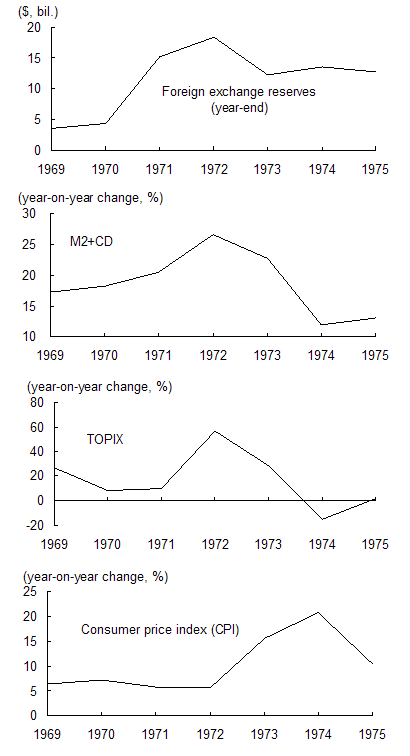
(Source) Bank of Japan and Tokyo Stock Exchange.
4. Assessment of Japan's Shift to a Floating Rate System
At the time of the Nixon Shock, fears of a stronger yen or the argument for avoiding it were dominant among policy-makers in Japan. As a policy to reduce the balance of payments surplus based on the premise that the exchange rate would remain unchanged, an eight-point program of yen-defense measures was implemented ("Concerning the Promotion of Comprehensive External Economic Measures," June 1971). The following areas formed the center of the program:
(1) Balanced current account by curbing exports and accelerating imports (abolishment of favorable tax and financial treatment on exports, deregulation to encourage imports, full enforcement of import liberalization)
(2) Balanced capital account through promotion of foreign investment and overseas assistance
(3) Fiscal and monetary policies to expand aggregate demand (expansionary fiscal expenditure policy, accommodative monetary policy)
(4) Adjustment-centered inflation policy (policy to raise domestic price level and money wage rate)
Against these arguments, the Foreign Exchange Policy Study Group, which consisted of 36 economists and was co-chaired by Akihiro Amano, professor at Kobe University, and Ryutaro Komiya, professor at the University of Tokyo, offered counterarguments on July 10, 1971. They said that "the appropriate policy mix would be to apply a change of the foreign exchange rate above everything else in order to achieve equilibrium in the balance of payments, and use other means to achieve other objectives"; based on recognition that Japan's balance of payments at that time continued to show a large surplus and was clearly in a state of fundamental disequilibrium( note 1 ). In light of this, the Group recommended adopting a "small-step adjustment mechanism" (crawling peg system) as soon as possible under the following terms. (See box for specific reasons for supporting a revaluation of the yen.)
"The range of a single parity change should be within 1%, and the currency realignment should be continued at a pace of making an adjustment once every three to five months, or at a yearly degree of 2.4% to 4%, until the balance of payments surplus is eliminated and accumulated excessive foreign exchange reserves are reduced, while taking the circumstances at that time into account. In such a case it is desirable that the Bank of Japan intervenes in the foreign exchange market to avoid a sharp fluctuation in the market rate. It is not necessary to rigidly consider the frequency and degree of the change, and it is also worth considering the method of making a single monthly realignment at a degree of 0.2% or 0.3%." (Foreign Exchange Policy Study Group , 1971)
The Foreign Exchange Policy Study Group indicated four key advantages of the small-step adjustment mechanism. First, unlike a significant parity change, exchange rate adjustments under this system would not trigger an influx of short-term capital intended for speculation or hedging. Second, it would be easy for each industry to adapt because the adjustment is made gradually. Third, since it would not be necessary to decide on the final degree of revaluation beforehand, it is acceptable to continue the adjustment until the surplus is eliminated and the excessive foreign exchange reserves are reduced. If the situation were to reverse itself, an opposite adjustment (devaluation) could be made. Finally, particularly in the case of Japan, this method would not violate the International Monetary Fund (IMF) agreement and could be implemented on the Japanese government's own initiative.
At the same time, Komiya and Suda (1983) collectively criticized the authorities' response to the Nixon Shock, writing: "Considering the macro situation of the Japanese economy at that time, it is difficult not to feel that the shift of the yen to a floating rate was long overdue. It was unfortunate that the scope of selection was narrowed for the foreign exchange authorities as Prime Minister Tanaka stated that the Japanese government 'must take every possible measure to avoid revaluation of the yen', and adhered to a policy of firmly maintaining the Smithsonian rate. ... The Japanese government should have adjusted the Smithsonian central rate (revalued the yen) or moved to a floating rate system much earlier, perhaps in the fall of 1972, as its own proactive option." Also, noting that inflation had already been progressing before October 1973 when the first oil crisis occurred, the authors declared that the expansionary macroeconomic policies pursued by the government and the Bank of Japan in the fall of 1972, which placed top priority on avoiding yen revaluation, caused a vicious price spiral in 1973 and 1974.
Opinions are divided over the evaluation of the long-term upward trend of the yen-against the dollar that follows the transition to a freely floating exchange rate system.
On one hand, McKinnon and Ohno (1997) assert that the long-term upward trend of the yen has been exerting strong deflationary pressure on the Japanese economy. With the yen rising at an annual rate of 4 percent since the 1970s and expectations of an ever-higher yen becoming the norm, interest rates in Japan have stayed below those in the U.S. by about the same margin (level of Japanese interest rates = level of U.S. interest rates - appreciation expectations of the yen vis-a-vis the dollar), reflecting interest-rate arbitrage. The situation was manageable while U.S. interest rates remained at a relatively high level. However, as interest rates began to fall in the 1990s, Japanese interest rates were driven lower and lower, and by the latter half of the 1990s, Japan fell into a "liquidity trap," a situation in which nominal interest rates could not go down any further as they approached the zero level. They argue that this has inhibited Japanese monetary authorities' capacity to implement effective monetary policy, thus resulting in the prolonged economic recession( note 2 ).
On the other hand Kuroda (2004) sees not the yen's appreciation itself but the monetary easing policy adopted as a way to alleviate deflationary pressure brought by the appreciation of the yen as the cause of the bubble economy in the latter half of the 1980s. The dollar's exchange rate against the yen, which was at around 240 yen at the time of the Plaza Accord in September 1985, fell below the 200 yen level at the end of 1985, then to 150 yen one year later. To help the export industry which had lost international competitiveness due to the yen's appreciation, the Bank of Japan (BOJ) cut the discount rate five times between January 1986 and February 1987 from 5 percent to 2.5 percent, and maintained that rate, which was a record low at the time, until May 1989. Meanwhile, based on the recognition that the objective of correcting the overvalued dollar had been achieved, in February 1987 finance ministers and central bank governors of the Group of Seven industrialized countries agreed in the Louvre Accord to seek to stabilize the U.S. dollar. With this, the BOJ embarked on aggressive dollar-buying interventions. The increasing money supply resulting from the sharp cuts in the discount rate and massive interventions in the foreign exchange market gave rise to excess liquidity, which was channeled into stock and real estate markets. This in turn added fuel to the asset bubble and paved the way to the problems the Japanese economy faced in the 1990s.
5. Lessons to Learn from Japan's Experience
As described above, China at present is in a transition period from a fixed rate system to a floating rate system, just as Japan was in the early 1970s. So what lessons should China learn from Japan's experience at the time?
First, the discussion about the merits and demerits of revaluation mentioned in the recommendations of the Foreign Exchange Policy Study Group contains a number of suggestions applicable to current issues facing the yuan. Among them, the emphasis on the adverse effects of an increase in the balance of payments surplus and the resulting accumulation of foreign exchange reserves, the idea of a policy mix aiming for an optimal combination of policies and instruments, and the criticism of the mercantilist view that looks at increased exports and the acquisition of foreign currency as major components of national interests, are all relevant to present-day China.
Second, at that time in Japan there was strong resistance to yen revaluation and the shift to a floating rate system, which caused a delay in the authorities' response. However, striving to maintain an undervalued exchange rate via market intervention provoked the ballooning of liquidity, which in turn gave rise to accelerated inflation and the asset bubble. Unfortunately, China has not taken advantage of this lesson and in recent years has allowed a similar situation to arise.
Third, as in Japan during the 1970s, it is difficult to simultaneously achieve stabilization of both prices and the exchange rate in a country where productivity is rising significantly in the tradable goods sectors (manufacturing industry) because the real exchange rate has been subjected to upward pressure for a long time. Authorities must set policy targets in keeping with the trade-off between rising prices and a rising exchange rate. Japan gave preference to the stability of prices and accepted the stronger yen; the inflation rate would have been much higher had Japan instead maintained the stability of the exchange rate.
Fourth, although it is said that liberalization of capital transactions is a prerequisite for a floating rate system, such liberalization is slow in China and some oppose an early shift to a floating rate system because the conditions for promoting liberalization of capital transactions have not yet been put in place. However, Japan's experience during the 1970s shows that it is possible to move to a floating rate system while maintaining capital regulations.
Fifth, the reforms carried out in 2005 to improve the exchange rate formation mechanism of the yuan and the small-step adjustment mechanism recommended by Japan's Foreign Exchange Policy Study Group in 1971 are both managed floating rate systems that could be classified as a crawling peg. Following rapid changes in the domestic and international situation, including the Nixon Shock, Japan moved to a floating rate system instead of adopting the small-step adjustment mechanism. Similarly in China, the current system should also be regarded as a transition measure. Given that its limitations have already been made known, China should move ahead with further reforms to establish a freely floating rate system.
Finally, Japan at that time had no other country's experience to use as a reference and was forced to move to a floating rate system without sufficient preparation after having used up all means to maintain the fixed exchange rate. Compared to that experience, China has a little more leeway. In fact, in contrast to Japan which had experienced the Nixon Shock, China did not carry out its 2005 reform in a crisis situation, although it was facing rising foreign pressure. China should prepare a roadmap in advance for its shift to a freely floating rate system, while referring to the experiences of other countries, including Japan.
The best timing for the final shift to a freely floating exchange rate system would be when the actual exchange rate of the yuan nearly conforms to an equilibrium rate that reflects the demand and supply in the market. That day is drawing near, as clearly shown by the fact that the premium on the one-year, non-deliverable forward (NDF) rate of the yuan over the spot rate in overseas transactions has fallen to around 3 percent as of August 21, from its level over 10 percent in the spring of 2008 ( figure 6 ).
Figure 6:Exchange rate of the yuan against the dollar - spot rate vs. forward rate
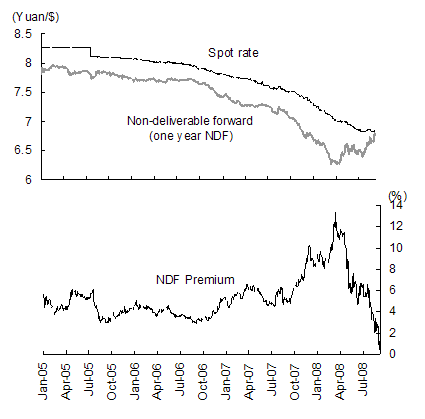
(Source) Bloomberg, State Administration of Foreign Exchange.
Box : Why was yen revaluation necessary?
- The view of the Foreign Exchange Policy Study Group -
In Japan at the time of the Nixon Shock, public opinion was dominated by opposition to revaluation of the yen. The main grounds for that argument were as follows.
- Revaluation of the yen is against national interests, which call for boosting exports and acquiring foreign currency.
- Devaluation of the dollar, rather than revaluation of the yen, or reform of the international monetary system that makes it possible, is necessary.
- The impact on the industrial sector will be significant.
- Once the yen is revalued, stability of yen parity will be lost, with no brake.
- The incentive for economic growth will be lost.
- The effect of stabilizing prices will be insignificant.
- There is no reason for revaluing a domestically weak yen.
The Foreign Exchange Policy Study Group countered these arguments, as follows, on the premise that the small-step adjustment mechanism would be adopted.
(1) Instead of serving the country's national interests, the accumulation of the balance of payments surplus is merely the result of the fact that the consumption, investment, and government expenditures of the home country - the original purposes of economic activities - are held below production. In addition, this will import inflation from deficit countries and make international financial cooperation difficult, with adverse effect on the national economy.
(2) Reforming the international monetary system to overcome the deficiencies of the dollar standard system cannot be implemented only by Japan, and it will probably take a long time to obtain agreement from many countries on such reforms. In contrast, the correction of adverse effects brought about in the Japanese economy by the accumulation of surplus is an urgent task that Japan must address on its own.
(3) Although Japanese exporters may have difficulty competing in overseas markets if the yen is revalued sharply, with their competitive edge strengthening over time, they should be able overcome the negative impact of a gradual appreciation under the small-step adjustment mechanism. Also, even if effective demand in Japan may decline and under-employment of domestic resources may occur because of a stronger yen, these problems can be solved by pursuing a more expansionary fiscal policy.
(4) In the event that Japan's structural surplus is expected to continue, a significant revaluation as a means of adjusting the balance of payments will have a large impact on the national economy each time it is implemented. However, the impact on the overall economy of gradual exchange rate adjustments under the small-step adjustment mechanism will not be as large as a significant revaluation.
(5) Although there are concerns that a revaluation of the yen rate may adversely affect the motivation to improve productivity, and thereby economic growth by capping wages and profits, it should be noted that the motivation for growth lies in various causes behind investment behavior and technological development, which have little to do with the relations between the rate of wage increases and the rate of productivity growth.
(6) The purpose of the yen revaluation is to reduce overall losses in the Japanese economy that will be brought on by the balance of payments disequilibrium( note 1 ), and price stabilization is only one of the aspects of revaluation. Even in terms of the effect of stabilizing prices, revaluation combined with import liberalization is expected to yield a more favorable effect than other alternatives, both as a balance of payments adjustment measure and in curbing prices.
(7) Revaluation of the yen will increase the yen's purchasing power externally and strengthen the yen internally.
These arguments seem applicable not only to Japan in the early 1970s, but also to present-day China.


